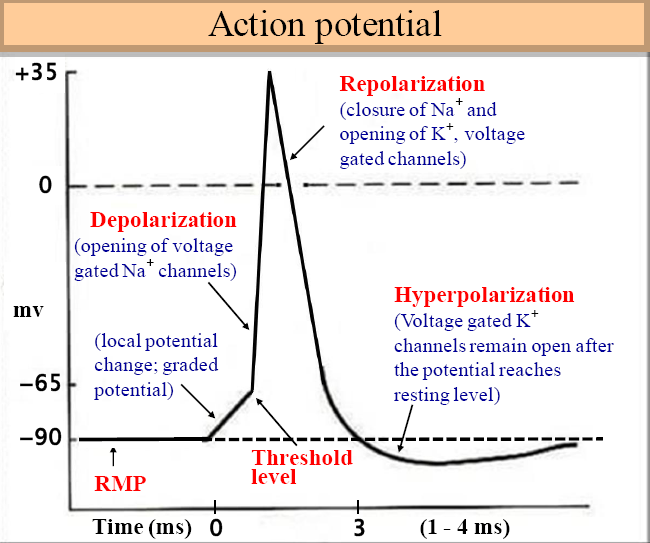Brief, rapid, large and reversible change in resting membrane potential of an excitable cell during which the membrane potential reverses (cell inside becomes more positive than outside) is known as action potential.
Before considering action potential, we must familiarize ourselves with the potential in the cell in resting state. We know that cell is electrically neutral.
Resting membrane potential
When the cell is at rest, cell membrane is negatively charged (polarized) from inside as compared to outside
Voltage gated channels:
Two types of channels are present:
1. Voltage gated Na+channels
2. Voltage gated K+channels
Voltage gated Na+channels:
When the cell is at rest (-90 mv)
►Activation gate (outer) closed
►Inactivation gate (inner) open
At threshold voltage (-70 to -50 mv)
►Activation gate opens -rapid process
►Inactivation gate starts closing -slow process
At peak positivity level (+35 mv)
►Inactivation gate closes
►Activation gate remains open
Voltage gated K+channels:
When the cell is at rest (-90 mv)
►Gate closed
At threshold voltage (-70 to -50 mv)
►Gate starts opening -slow process
At peak positivity level (+35 mv)
►Gate opens
►Remains open till resting membrane potential is is restored
During repolarization (+35 to -90 mv)
►Gate starts to close -slow process
Now let us consider action potential which occurs only in the excitable cells.
Excitable cells:
These are the cells with the capability to generate action potentials, mostly are the nerve and muscle cells
RMP to threshold level (-90 to -65 mv)
1. Opening of voltage gated Na+channels (electrical stimulus)
2. Opening of mechanically gated Na+channels (mechanical stimulus)
3. Opening of ligand gated Na+channels (chemical stimulus)
Stages of action potential
1. Depolarization (-65 to +35 mv)
►Opening of voltage gated Na+channels
►About 5000 fold increase in Na+permeability
►Voltage rises and crosses zero (overshoot)
2. Repolarization (+35 to -90)
►Opening of voltage gated K+channels
►Closure of voltage gated Na+channels
3. Hyperpolarization
►Some voltage gated K+channels remain open even after RMP (-90 mv) is restored
►Potential decreased more than resting level
►Na+ -K+pump restores RMP from hyperpolarization
All or none principle
►Action potential will either be generated or not…no gradations or intensities or possible
►Suprathreshold stimulus will elicit same action potential as elicited by threshold stimulus
►Subthreshold stimulus will not elicit action potential
Re-establishment of ionic gradients:
During action potential Na+& K+ionic gradients reverse. In this condition cells contain:
►Large amount of Na+(due to massive Na+influx)
►Too less amount of K+(due to massive K+ efflux)
Na+ -K+pump re-establishes ionic gradients (recharges the nerve fiber)
Refractory period
1. Absolutely refractory period
Period during which a 2nd action potential can not be generated. This can be elicited:
►From start of depolarization to initial 1/3 of repolarization
►After closure, the inactivation gates do not reopen until RMP is restored
It is mostly of 0.4 ms in large myelinated nerve fibers.
2. Relative refractory period
Period during which 2nd action potential can be generated but with stronger than normally required stimulus. This can be elicited:
►From end of initial 1/3 of repolarization to start of after depolarization (middle 1/3rd)
►Some voltage gated Na+channels regain their resting configuration
During this period K+efflux continues.
Refractory period
limits frequency of action potentials.
►Longer the refractory period, less will be the frequency
►Absolutely refractory period of large myelinated nerve fiber is 0.4 ms, therefore, frequency of action potential is 2500/second
►Determine direction of action potential
►Action potentials can not be summated
Clinical implications
►Action potential is the basis of following clinical investigations
►Electrocardiography (ECG)
►Electroencephalography (EEG)
►Nerve conduction study (NCS)
Local anesthetics
Procaine, Tetracaine etc block voltage gated Na+channels, thus
►No action potential occurs
►No nerve signal from periphery to brain
►No sensation of pain
Propagation (conduction) of action potential
Propagates along nerve fiber as nerve signal or nerve impulse
►Means of communication between neurons or nerves and muscles.
► Causes muscle contraction
An axon stimulated in centre will conduct nerve impulse in both the directions.
Conduction of nerve impulse
►Nerve impulse conduction is always unidirectional
►Chemical synapses are unidirectional
►Ensure one way transmission of nerve impulse
Orthodromic conduction
►From neuronal cell body to axon
►Normally occurs in living animals
Antidromic conduction
►From axon to neuronal cell body
►Dies out at synapse
Types of nerve fibers (based upon myelination)
Myelinated fibers
►Covered by myelin sheath
►Large diameter fibers (A fibers) carrying touch and pressure sensations to CNS
►Somatic motor fiber to skeletal muscle
Unmyelinated fibers
►Not covered by myelin sheath
►Small diameter fibers (C fibers) carrying dull pain sensation to CNS
►Post ganglionic autonomic fibers
Myelin sheath
►Fatty material
►Produced by Schwann cells
►Wraps around the axon in multiple layers
►Insulates the nerve fiber
►Ionic exchange can not take place through myelin sheath
Nodes of Ranvier
►Parts of myelinated nerve fiber devoid of myelin sheath
►Present after every1-3 mm of myelinated part of nerve fiber
►Are in contact with ECF
►Have abundance of voltage gated Na+channels
►Sites of action potential generation
Types of conduction
Contiguous conduction
►Occurs in unmyelinated fibers
►Every part of nerve fiber undergoes depolarization
►Slow speed of impulse conduction
►More energy consumption
Saltatory conduction
►In myelinated nerve fibers
►Depolarization occurs only at nodes of ranvier
►Myelinated parts do not depolarize
►Activation ‘jumps’ from node to node
Importance
►More velocity of conduction
►Less ionic disturbance
►Energy conservation
Safety factor
►Ratio of local potential change to threshold for action potential
►Safety factor >1
►Ensures propagation of action potential
►Safety factor < 1
►Action potential will not be generated
Multiple sclerosis (MS)
►An autoimmune demyelinating disease
►Velocity of nerve impulse decreases
Action potential with plateau
►Occurs in cardiac muscle
►Sustained depolarization due to:
1. Presence of voltage gated Ca++ -Na+channels (slow channels)
2. Slow opening of voltage gated K+channels
Autorhythmicity
Repetitive self induced action potentials. Occurs in:
►Heart, neurons, smooth muscles
Cause
►RMP less negative
►Cell membrane leaky to Na+
Subthreshold stimulus -voltage does not reach threshold
►Threshold stimulus -voltage reaches threshold
►Suprathreshold stimulus -voltage rises above threshold
 howMed Know Yourself
howMed Know Yourself




nice notes